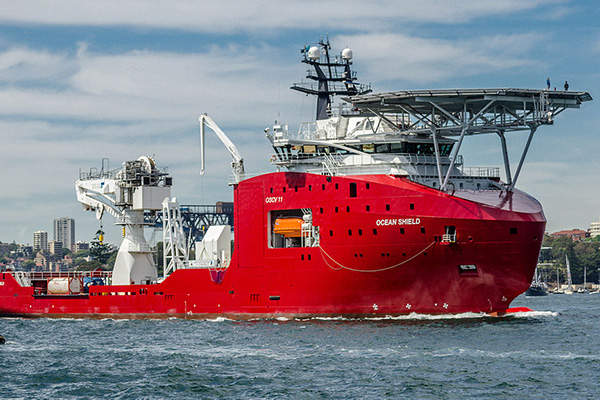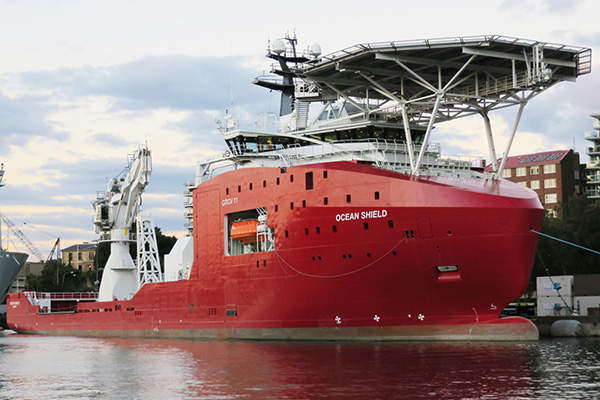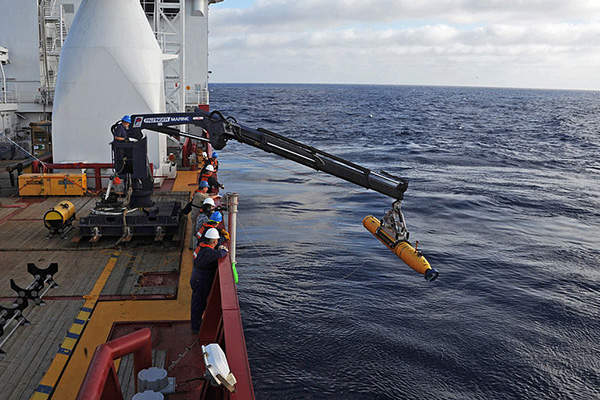ADV Ocean Shield is a humanitarian and disaster relief vessel of the Royal Australian Navy (RAN). Formerly known as Skandi Bergen, the ship was originally built by STX OSV (now VARD) as an offshore support vessel for the Norwegian shipping company DOF ASA.
It is the sister ship of the ACV Ocean Protector that is currently operated by Australian Customs and Border Protection Service. It is home-ported at Fleet Base East (HMAS Kuttabul) and is operated and managed by civilian crew.
The vessel participated in Operation Southern Indian Ocean to hunt for the black box of the missing Malaysian Airline flight MH-370 in 2014.
Construction of the 6,500t ADV Ocean Shield began at STX OSV shipyard in Tulcea, Romania in April 2011 and the final outfitting was completed at STX’s Søviknes shipyard in May 2012. Sea trials were conducted by Teekay Shipping, which is also responsible to operate and man the ship with civilian crew.
The ship joined the Royal Australian Navy’s existing fleet of amphibious ships HMAS Choules and HMAS Tobruk.
The Kedah Class Offshore Patrol Vessels (OPV) are built by Blohm + Voss and PSC Naval Dockyard (now known as Boustead Naval Shipyard) for the Royal Malaysian Navy.
Acquisition of ADV Ocean Shield
The Australian government announced its decision to procure the vessel after Cyclone Yasi hit North Queensland in February 2011 when no amphibious ships from RAN were available for relief operations. Skandi Bergen was acquired from DOF Subsea Rederi, a subsidiary of the DOF Subsea Group, in March 2012 for approximately $130m. The purchase was facilitated by Sea Force, a defence engineering consulting company based in Australia.
The vessel required minimal modifications and was delivered to the RAN without its subsea equipment including two work-class remotely operated vehicles (WROVs), launch and recovery systems for the two WROVs and a 250t crane. It arrived at Perth base HMAS Stirling on 28 June 2012.
The ship was renamed Ocean Shield with the prefix ‘Australian Defence Vessel’ and entered into service on 30 June 2012.
Ocean Shield mission capabilities
The primary role of Ocean Shield is to transport supplies and troops for humanitarian missions and disaster relief operations both in Australia and the surrounding region.
Ocean Shield can carry out patrols in the Southern Ocean and even operate in sub-Antarctic weather conditions. It is also capable of conducting surveillance and detection of illegal vessels.
Ocean Shield will be transferred to the Australian Customs and Border Protection Service after the introduction of two new Canberra-class landing helicopter dock ships (LHDs) into service in 2016, and will replace the Ocean Protector.
Design and features
The ship has a mono-hull and a bulbous bow section, and is 106m long and 22m wide. The vessel has 6.6m draught and a deck with an area of 1,100m² providing cargo space. The vessel can accommodate up to 100 people and has 22 single cabins and 39 double cabins.
ADV Ocean Shield is a Dynamic Positioning Class 2 vessel with two independent computer systems that automatically maintain its position and heading at sea under specified environmental conditions. Information from satellites and its own sensors are used to control the vessel’s propellers and thrusters.
The ship has ICE-1B DNV classification and can move through ice floes of thickness up to 0.6m. It is equipped with de-icing/anti-icing systems that prevent the icing up of ladders, hatches and emergency doors, thus enabling patrols and missions in the southern waters near Antarctica.
A 21m x 21m helipad is provided that can accommodate a medium sized helicopter.
Propulsion
The diesel-electric propulsion system consists of four Wärtsilä 6L32 2,880kW medium speed diesel generators, and two Rolls-Royce Contaz 35 3,000kW azimuth thrusters at the stern. Two 1,800kW tunnel thrusters are located at the bow and a 1,500kW retractable azimuth thruster near it. The propulsion system ensures a maximum speed of 16kt.
MH-370 search operation by ADV Ocean Shield
ADV Ocean Shield joined the international search effort in the Southern Indian Ocean to locate the black box recorder of the missing Malaysian Airline flight MH-370 in March 2014.
Ocean Shield was fitted with specialist underwater search and location equipment, including a Towed Pinger Locator (TPL-25) and a Bluefin-21 Autonomous Underwater Vehicle (AUV), supplied by the US Navy.
The TPL-25 system, which has a range of 1.6km and capable of going to a depth of up to 6,000m, was used to detect the audio Pinger of the black box. The AUV was deployed to scour the seabed in the area using electronic sensors to locate potential debris.
Ocean Shield spent two months searching through 850km2 of the ocean but the search equipments were unable to detect conclusive evidence of the missing plane.
Australia Defence Sector – Market Opportunity and Entry Strategy, Analyses and Forecasts to 2015
Detailed analysis and forecasts of the Australia defence market are available from our business information platform Strategic Defence Intelligence. For more information click here or contact us: EMEA: +44 20 7936 6783; Americas: +1 415 439 4914; Asia Pacific: +61 2 9947 9709 or via email.







.gif)




